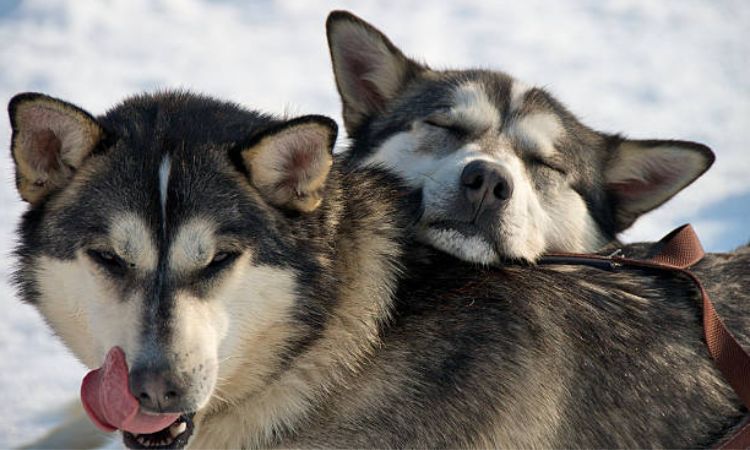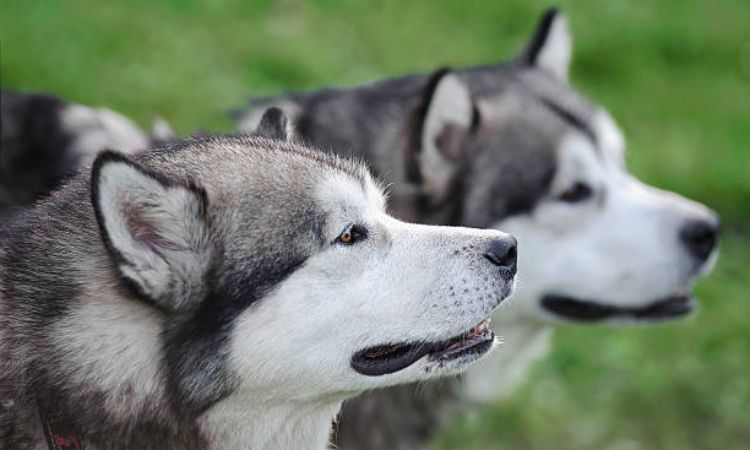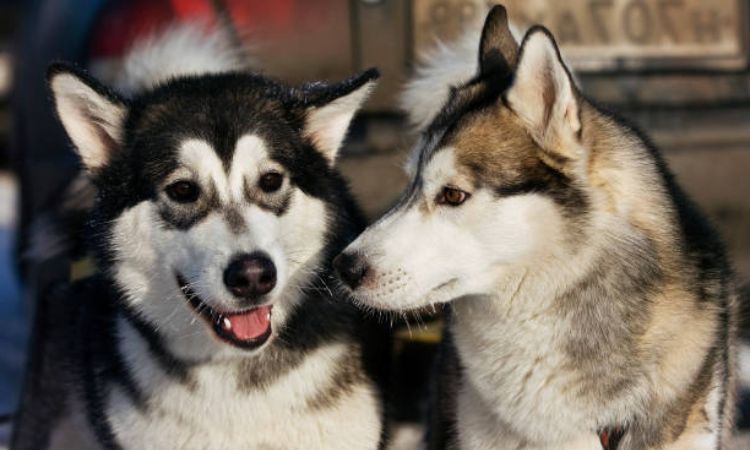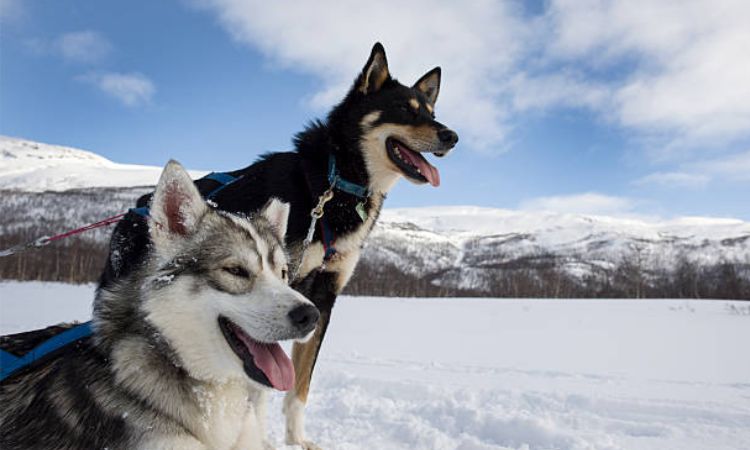The Alaskan Dog is a striking little companion with both beauty and brains. Compact and agile, it moves with effortless grace, its well-proportioned body slightly longer than it is tall. With a wedge-shaped head, upright triangular ears, and a thick double coat in sharply contrasting colors, its appearance clearly reflects its Arctic roots.
A loosely curled tail adds to its expressive charm. Curious, intelligent, and reserved around strangers, this breed is as intriguing in personality as it is in looks. Let’s explore the Alaskan Dog’s origins, characteristics, and temperament in more detail.

Origins of Alaskan Dogs
Alaskan dogs have a long and storied history shaped by centuries of adaptation to the harsh Arctic climate and close partnerships with native peoples. Their origins trace back more than 4,000 years to ancient wolf-like dogs that migrated with nomadic tribes from Siberia across the Bering Strait into what is now Alaska. Over time, these dogs evolved into specialized sled-pulling companions, indispensable for survival in unforgiving northern terrain.
- Mahlemut Inuit Legacy: One of the most influential tribes in shaping the Alaskan Malamute was the Mahlemut Inuit people, who lived along the coastlines of Kotzebue Sound. The tribe selectively bred strong, enduring dogs capable of hauling heavy sleds through snow and ice. These dogs, known today as Alaskan Malamutes, were prized not only for their physical prowess but also for their loyalty and ability to coexist peacefully with humans, often sleeping beside families to provide warmth.
- Siberian Roots: The early ancestors of these Arctic dogs likely resembled wolves in build and temperament. Brought from northeastern Asia by early settlers, they gradually adapted to life in the sub-zero environments of North America. Natural selection and careful breeding by the Inuit led to the development of dogs with dense double coats, bushy tails, strong limbs, and remarkable endurance.
- Evolution of the Alaskan Husky: Unlike the purebred Malamute, the Alaskan Husky is a more recent, purpose-bred working dog with mixed ancestry. Developed primarily for racing and efficient sled-pulling, this type includes genes from Siberian Huskies, German Shepherds, Border Collies, and other high-performance breeds. The focus was not on looks but on speed, stamina, and agility.
- Environmental Influence: Alaska’s freezing temperatures, snowy landscapes, and long winters played a crucial role in shaping these breeds. Only dogs with the hardiness to survive and thrive in such a demanding climate were kept and bred, resulting in animals with tough feet, thick fur, and a drive to work closely with humans.
In essence, the origins of Alaskan dogs reflect both their deep ancestral roots and the profound bond between people and animals in one of the world’s most challenging environments.

Physical Traits and Characteristics
Alaskan dogs are bred and developed for their strength, endurance, and adaptability to extreme cold climates. While Alaskan Malamutes and Alaskan Huskies share some similarities, each type has distinct physical traits and structural differences that reflect their historical roles and breeding priorities.
Alaskan Malamute
- Large and powerful build, typically standing 23–25 inches (58–64 cm) tall at the shoulder and weighing between 75–100 pounds (34–45 kg).
- Dense double coat: the outer coat is coarse and weather-resistant, while the undercoat is thick and woolly, providing insulation against harsh Arctic temperatures.
- Broad chest, heavy bones, and strong muscles – ideal for pulling heavy sleds over long distances at a steady pace.
- Characteristic wolf-like face with erect ears, a full plume tail that curls over the back, and almond-shaped brown eyes.
Alaskan Husky
- Not a standardized breed but a type bred specifically for sledding performance; varies in size, typically medium to large, weighing between 40–60 pounds (18–27 kg).
- Lean, agile body with longer legs and narrower chest than the Malamute, giving them better speed and stamina.
- Coat is shorter and less dense than that of Malamutes but still provides good protection in sub-zero temperatures. Coat color and eye color can vary widely.
- Bred for athleticism, speed, and teamwork, often with a mixed ancestry including Siberian Husky, German Shepherd, Greyhound, and Border Collie.
Wolf-like features in related breeds
- Breeds like the Tamaskan were developed to resemble wolves in appearance while maintaining domestic dog temperament and working ability.
- These dogs often exhibit a similar thick coat, upright ears, and elongated snout reminiscent of their Arctic ancestors.
Adaptations for cold weather
- Thick insulating undercoat to maintain body heat in sub-zero conditions.
- Strong feet with tough pads and fur between the toes for snow travel.
- High physical endurance and lung capacity, allowing sustained effort during long-distance sled runs.
- Metabolic efficiency in extreme climates, enabling them to thrive on high-fat diets and exert energy consistently.
Temperament and Personality

Alaskan Malamute
The Alaskan Malamute is often described as a gentle giant. They are friendly and affectionate dogs that form strong bonds with their families. Their pack mentality means they thrive on companionship and enjoy being involved in family activities. While they are playful and loving, Malamutes are also independent and strong-willed, so they need consistent training from an early age to keep their behavior in check.
Socializing them early is important, especially to manage their natural prey drive, which can make them less suitable around smaller pets without proper introduction. Overall, they are loyal, loving dogs that flourish in an active and structured environment.
Alaskan Husky
Alaskan Huskies are energetic, sociable, and affectionate dogs bred specifically for endurance and teamwork. They are happiest when running and working alongside their human companions, showing impressive stamina and a strong desire to be part of a pack.
These dogs don’t like to be left alone for long periods—they thrive in a busy environment with plenty of exercise and mental challenges. Despite their high energy, they are friendly and playful, making them great companions for active families who understand their need for regular physical activity and social interaction.
Tamaskan and Other Related Breeds
Tamaskans and other similar wolf-like breeds combine intelligence with a calm and gentle nature. Known for their eagerness to please, these dogs adapt well to family life and enjoy interacting with people and other pets. Their high intelligence means they respond well to training and excel in various roles, from obedience competitions to therapy work.
Like other northern breeds, they require daily exercise and mental stimulation to keep boredom and unwanted behaviors at bay. Their balanced temperament makes them excellent pets for families prepared to give them both physical and emotional attention.

General Behavioral Traits
All these Alaskan-related breeds share certain core traits. They are smart and quick to learn but often need clear leadership to stay focused. Their stamina and endurance make them perfect for active lifestyles, especially those involving outdoor activities.
Socially, they are expressive dogs that rely heavily on communication with their human families, so they need consistent interaction and mental engagement to stay happy. Without enough physical and mental outlets, these dogs can become bored or develop behavioral problems, so providing a stimulating environment is key to their well-being.
In conclusion, Alaskan dogs are a remarkable group of breeds with a rich history rooted in the harsh northern environment. Their unique traits and resilient temperaments make them a fantastic choice for experienced owners who can provide them with the proper care and active lifestyle they need to thrive.






